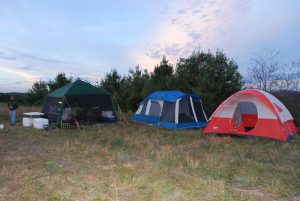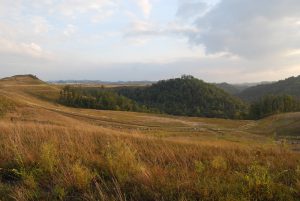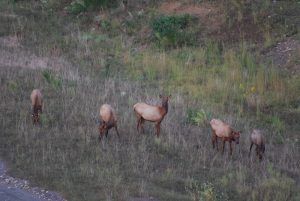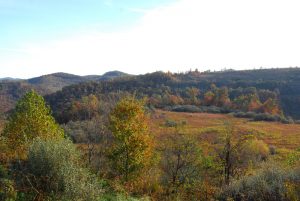By guest blogger Christian Berg, editor of Petersen’s BOWHUNTING magazine
When you hear the words “organic protein,” you might think about free-range chicken or grass-fed beef from the local health food store. When I use the term, I’m talking about wild game meat I’ve harvested myself. I am a bowhunter, and as my friends and I like to say, we make meat the old-fashioned way. No hormones. No antibiotics. No 150-mile truck ride from the slaughterhouse to the store. And no foam containers and plastic wrap. Just fresh, wholesome meat that goes directly from field to freezer. As far as I am concerned, it doesn’t get any better than that!

During his October 2010 Kentucky elk hunt, Christian Berg was able to camp and harvest his cow elk on a Wildlife Management Area owned and managed by the state Department of Fish and Wildlife Resources.
I got to know Maria about six years ago during my former life as the outdoor writer at the local newspaper in Allentown, PA. As our friendship has developed, I’m pleased to say I have had several opportunities to share my game meat for use in Maria’s country kitchen. My latest donation—two pounds of ground elk—was delivered last week, and resulted in an invitation from Maria to become an occasional contributor to her blog. So, here I am!
As I was telling Maria, elk meat (check out a delicious elk recipe from Maria!) is really a lot more than just a nutritious meal. It’s a celebration of a tremendous conservation success story that has played out in the past 15 years. In 2010, I was extremely fortunate to be among the 800 winners in Kentucky’s “elk lottery,” receiving a permit to hunt for a cow elk. Now, the opportunity to go on ANY elk hunt would be enough to get me excited. But drawing this particular tag was even more special, because the thought of hunting wild, free-ranging elk in the Bluegrass state would have been impossible just 20 years ago.

Although most people would not expect to find beauty in a strip mine, the reclaimed strip-mining land of Eastern Kentucky has been transformed into wildlife habitat that is absolutely stunning!
Elk were common in Kentucky back in the days of Daniel Boone, but by the mid-1800s they had been extirpated amid of flood of settlement and habitat destruction. It wasn’t until 1997—after a 150-year absence—that elk returned to Kentucky, thanks to a reintroduction effort coordinated by the state Department of Fish and Wildlife Resources and the Rocky Mountain Elk Foundation. From 1997-2002, just more than 1,500 Rocky Mountain elk were trapped in Western states and released in a 16-county restoration zone in Eastern Kentucky. From those initial animals, the Bluegrass state is now home to a thriving population of more than 10,000 elk, which easily ranks as the largest wild elk herd east of the Rockies. High-quality habitat is the biggest reason elk are thriving. The restoration zone contains vast expanses of reclaimed coal-mining land that has been turned into grassland, very similar to traditional western elk range you would see in places such as Yellowstone National Park. So, Kentucky’s restoration effort is also showing the environmental benefits of responsible land stewardship.

A small group of cow elk grazes in a grassland area created on former strip-mining land in Eastern Kentucky.
As a hunter, I am proud my license dollars and donations made to groups such as the Elk Foundation are being used to support wildlife and habitat conservation. With all the bad news these days about the state of our environment, Kentucky’s elk revival is an example of what can be accomplished with the right vision and leadership. So when I was able to take a fat cow elk during my hunt last October, the success was not mine alone, but really a tribute to the entire restoration process that made it possible. There is every reason to believe Kentucky’s elk herd will continue to grow, and serve as a tremendous boost to the state’s ecotourism efforts and—at least for those lucky enough to win a license—provide a source of delicious, organic protein.
To watch video footage of Kentucky elk and hear more about the state’s elk restoration effort, visit www.youtube.com/watch?v=tQ-GJvcg2-0
Christian Berg is editor of Petersen’s Bowhunting magazine. When not behind the editor’s desk, you can find Christian flinging arrows on the target range or pursuing deer, wild turkeys, elk and other game throughout North America.
Related Stories:
E. Coli Survival Guide – Rodale.com
Bowhunting Magazine






Truly interesting, especially since I grew-up in Emmaus (worked @ Rodale a long time ago) and now live in Kentucky. I will post to my FB page.
Thanks for this interesting info.
Elk meat is the tastiest, best meat.
Personal favorite meats are: #1 Elk, #2 Moose and #3 my own home grown beef.
PS I have never tasted the famous Japanese beef.
If I am not mistaken, freezers are not old fashioned. Salting, drying, fermenting, canning, now those are old fashioned 🙂
Sounds delicious and thank you for sharing about the stewardship.
My dad was a hunter (and at 81 wishes he could go on one more hunt!). I grew up eating elk (roasts, steak, burger), venison (jerky, salami), antelope, pheasant and moose. I agree elk is the tastiest, best meat! In reading the article, I was happy to learn that elk have been reintroduced to their home and are thriving. Cheers!!
Awesome. Always good to see habitat restored and native animals returned. We hunt elk here in the Northeastern Oregon mountains now, but they were a plains animal that adapted to mountainous regions due to human population pressures.
I have an elk tag for this fall – hoping for the best!
When it comes to meat, nothing beats wild.